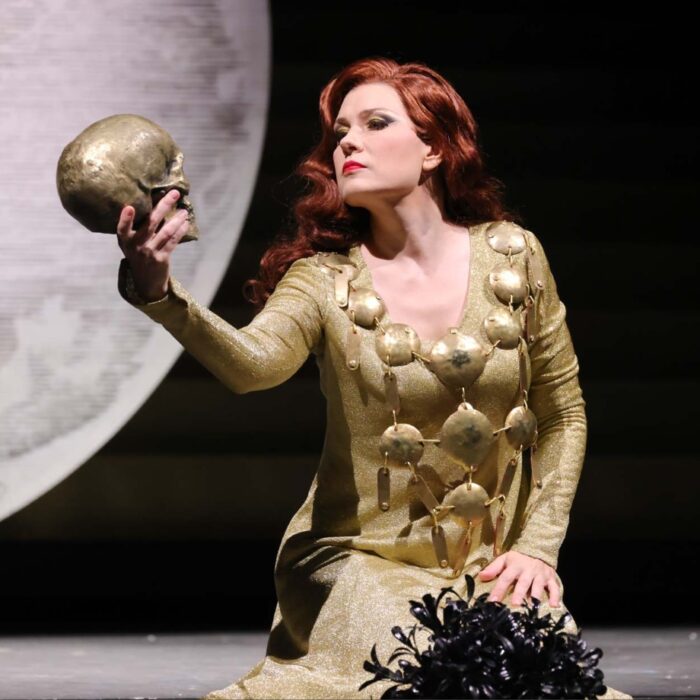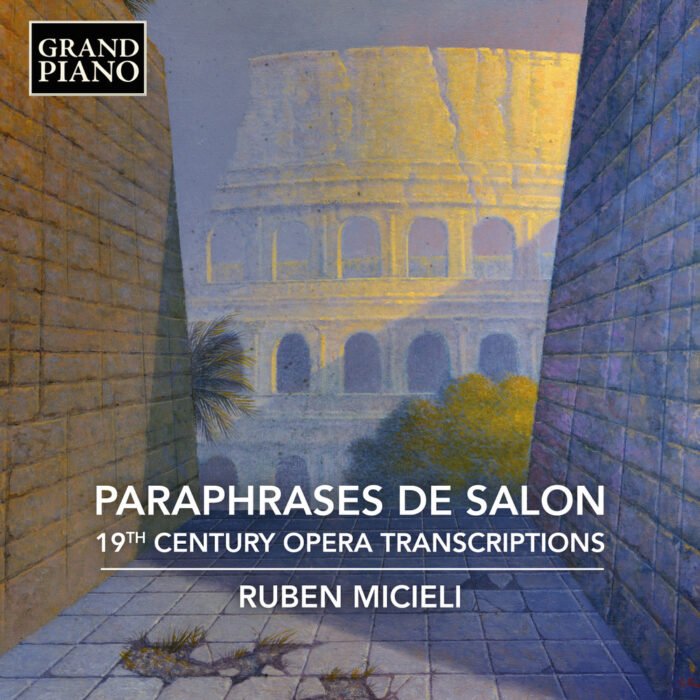
New Amsterdam Opera 2017-18 Review – La Favorita: Steven LaBrie & Catherine Martin Give Star-Studded Performances In Donizetti’s Rarely Performed Gem
By Francisco SalazarFor the past three years, the New Amsterdam Opera has been showcasing emerging opera stars and repertoire staples that are no longer performed as frequently in New York. The company has been consistent thus far in the quality of its performances and on June 2, 2018, it presented Donizetti’s “La Favorita” with two radiant leads that should be on the radar of major opera companies.
It was also a special evening as the company was honoring the late baritone Dmitri Hvorostovsky, who performed the work back in 2001 with the Opera Orchestra of New York.
The Leading Man
While Fernando is the leading role in the opera, it was baritone Steven La Brie, in the role of Alfonso, that easily stole the show.
From the moment LaBrie entered the stage, he showcased a dominant presence that overpowered anyone on stage. He quickly captivated with his confident phrases in his aria “Vien Leonora a’piedi tuoi.” His voice, suave and ardent, moved about with flexibility as he shaped the lines with passion. Though his cadenza in the middle of the aria had some muddled coloratura, he perfectly controlled the line returning to a gorgeous mezza voce.
During his subsequent cabaletta, LaBrie gave his baritone a more heroic stance that demonstrated command of his instrument. It was vocal fireworks without superficial vocal pyrotechnics, such as interpolating unnecessary high notes.
But more potent was his Act three aria, “A Tanto amor.” Here he sang with tenderness, caressing each phrase with a gorgeous piano that crescendoed to a forte. His phrases grew in volume as the aria developed, showcasing the ardor and love for Leonora. It was easily the most beautiful moment of the evening and one that showed the varied colors this singer can give.
But what also made LaBrie’s performance standout was his stage presence. While he was constrained to a stand (it was a concert performance), he was one of the few who tried to interact with his castmates. Whether it was just looking over at his Leonora from the opposite side or not walking on with music in Act three during a brief recitative, this made for a potent portrayal and allowed the audience to get a picture of who this character is. It also engaged the audience to focus on each gesture. Whereas this character could easily be considered a villain, LaBrie made Alfonso a sympathetic character.
A Star Mezzo
In the title role as Leonora, Catherine Martin brought a lush mezzo voice with agility in the coloratura and an even line. While her opening lines in the duet “Ah. mio bene” gave off some uncertainty, she quickly warmed up to showcase a rich timbre moving through the music with ease. During her duet with LaBrie, “In questo suolo a lusingar tue cure,” the two singers’ voices easily meshed, combining Martin’s anguish with LaBrie’s ardent passion. And as Act two built toward’s its finale, Martin’s desperation and torment built. Her voice grew with force and the sometimes icy qualities of the timbre shaped into a passionate outburst.
And it all climaxed in her Act three scene with the aria “O Mio Fernando.” This was perhaps the highlight for Martin. The mezzo gave the aria a yearning quality that expressed Leonora’s suffering and shaped each line with a delicate legato. This was in stark contrast to her cabaletta “Scritto e in ciel,” which not only showcased the soprano’s virtuosic agility, but also the fierceness in the voice and her dramatic weight. What made the cabaletta even more potent was Martin’s growing intensity and the fact that she never indulged in unnecessary coloratura. She sang each phrase with immediacy, giving the final moments force.
In Act four one finally saw the dramatic voice that Martin has. There was conflict, torment, and desperation within each of her phrases. But as the final duet built toward the climax in which the first act duet is repeated, Martin brought a bright color to her timbre. There was a moment of ecstasy as she unleashed her full vocal power. As Leonora sings her final dying phrases, Martin gave off a pure piano sound with such finesse that it was arguably the most heartbreaking moment of the evening.
Like LaBrie, Martin was as active as she could be on stage, interacting with her partners and reacting to the text with precision and immediacy. One got the sense that Martin wanted to move toward her partners and be able to have more contact, which only made this reviewer picture what a fully staged “Favorita” would be like with Martin allowed to have more physical contact with her castmates. Nonetheless, Martin perfectly suited for this role and one hopes to see this mezzo get a fully staged production in the future.
An Uneven Tenor
But it was not all perfect.
In the role of Fernando, tenor Peter Scott Drackley was arguably miscast. To say Drackley could not sing the role would be a disservice to this tenor’s ability. He has the notes, the expressive quality and the Italianate sound. But the biggest problem is the sense of security and finesse that the bel canto repertoire demands. Drackley has a grainy timbre with immense volume and weight that seems more fit to heavier repertoire. And that was apparent in his opening aria “Quegli accenti, odi tu.” Drackley began with a hesitant tone that seemed shaky in many moments. However, he recovered singing with an ardent tone phrasing each line with a connected line. It was in his upper register where the tenor fell short as he cut the climactic C sharp short and the aria’s effect was lost. In his subsequent cabaletta “Non sai tu che d’un giusto al cospetto” Drackley’s voice better served the part, displaying a heroic timbre that gave another dimension to the character.
In the famous duet “A Mio bene,” Drackley and Martin didn’t immediately connect. Part of it was that they were standing on opposite sides. The result was that they were often not together in time. But once the duet developed, they were more secure. Still, Drackley felt a bit under-powered next to Martin, whose voice resonated with her lush tone.
He also felt a bit constrained in the act three finale where Fernando calls out Leonora for being the king’s lover. The emotional cries of “Favorita del re” were restrained and it seemed he was reserving his voice for the final act.
Indeed Act four was his best act. In “Spirto Gentil” Drackley sang with a fil di voce, showing a purity of sound that was not seen throughout the evening. And this made for a beautifully phrased lament. His ascension into the upper register was effortless and it rang with a gorgeous color. In the final duet with Martin, Drackley was also at his most unhinged, but in a good way. One could finally hear the passion and the virile voice. He was no longer constrained and he seemed liberated. His final “e spenta” was beautifully sung with resonant power and desperation. Perhaps the limitations of Drackley’s performance were due to the fact that this was a new role and it would be interesting to see how the role develops in his voice.
The Supporting Players
In the role of Baldassare, Kevin Thompson sang with a booming tone. The bass has an immense sound that can easily fill any hall and he did just that at every moment he could. The big problem, however, was that he lacked a wide range of vocal colors. His expressions, both vocal and facial, were exactly the same throughout the night, making for a one-dimensional character. While his voice is one filled with an exciting sound, the lack of diverse phrasing made his portrayal predictable. Another issue with the lack of dynamic range was that he easily covered his castmates in moments where his bass was not as crucial to the ensemble.
As Ines, April Martin showcased a sweet and tender voice in her short but crucial aria “Bei Raggi Lucenti.” Her melting middle voice and her agile coloratura lines brought out a youthful character. However, her voice tended to lose color in her high register turning strident. That was most apparent in the cavatina “Dolce Zeffiro,” which lacked finesse in the stacatti phrasing. And her final interpolated high note was ill-conceived as the note was harsh and colorless.
And Then the Orchestra
Another huge issue was the orchestra. While music director Keith Chambers had a great sense of tempi and always gave his singers the space for each line, the orchestra didn’t always respond. During many moments such as the concerto in Act two, the orchestra covered the singers and in the duet between Alfonso and Leonora, the orchestra seemed to be ahead of the Martin and LaBrie. Perhaps this was due to the hall and the balance issues it may have, but that was something that became a consistent issue throughout the evening.
The style also became an overlying issue. There were many times when the percussion and brass sections delivered bombastic sound that seems a bit out of place in the Bel Canto repertoire. And then there were moments where the warmth and the Italianate sound were replaced with staccato phrasings. One such moment was the opening cello solo of Act four. The cellist avoided any lush portamenti and instead replaced them with static phrases that sounded more like music out of a Bach cello suite than that of a Donizetti opera.
One does have to give credit to the chorus. While there were only 17 members in the vocal ensemble, they still pulled off the incredibly challenging music with spirit and determination. Their voices resonated throughout the hall and were a great support for the concerti in Act two and three.
Regardless of the evening’s flaws, there was one thing present and that was the spirit of the New Amsterdam Opera. It was able to bring two artists at their vocal heights and bring unforgettable portrayals to the New York audience. Moreover, one has to commend the company for bringing this rare gem back to New York and this alone makes this company one to keep an eye out for. Already excited for what is to come next year.


